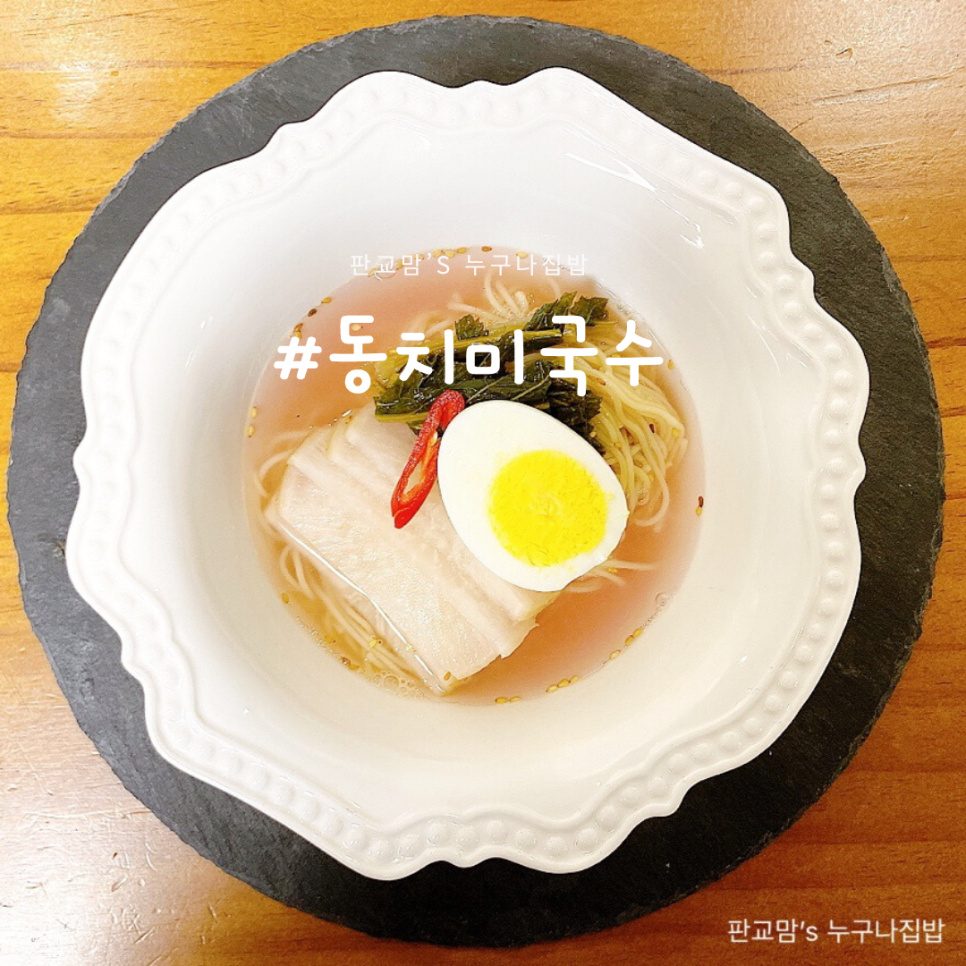Refreshing and Cool Dongchimi Noodles
Making Delicious Dongchimi Noodles with Winter Radish

After a family event over the weekend, your husband found the meal a bit too rich and suggested having Dongchimi Noodles on the way home. So, I prepared this refreshing dish! Dongchimi noodles are a delightful Korean cold noodle dish, perfect for cleansing the palate. The combination of the tangy, icy dongchimi broth, chewy somyeon noodles, and a savory seasoning mix creates a truly unforgettable taste experience.
Main Ingredients- 1 well-fermented Dongchimi radish (prepared)
- 2L water (for Dongchimi broth)
- 400g Somyeon (thin wheat noodles)
Seasoning- 4 Tbsp Soy Sauce
- 2 Tbsp Sugar
- 2 Tbsp Plum Extract (Maesil-cheong)
- 4 Tbsp Perilla Oil (Deul-gireum)
- 2 Tbsp Toasted Sesame Seeds (whole or crushed)
- 4 Tbsp Soy Sauce
- 2 Tbsp Sugar
- 2 Tbsp Plum Extract (Maesil-cheong)
- 4 Tbsp Perilla Oil (Deul-gireum)
- 2 Tbsp Toasted Sesame Seeds (whole or crushed)
Cooking Instructions
Step 1
Begin by filling a large pot with 2L of water for cooking the somyeon noodles and bring it to a boil. While the water heats up, prepare the other ingredients.

Step 2
While the water is heating, slice the dongchimi radish into bite-sized pieces (about 1-1.5cm thick semi-circles or cubes). Set aside. Cutting them too thinly might reduce the pleasant chewiness.

Step 3
Once the water comes to a rolling boil,

Step 4
Add 400g of somyeon noodles and start boiling them.

Step 5
To prevent the noodles from sticking together, gently stir them with chopsticks from the beginning until the end. Consistent stirring is key to achieving perfectly chewy noodles.

Step 6
When the noodles begin to boil over, add about half a cup of cold water to the pot. Repeat this process two more times, for a total of three additions of cold water (1st boil-over: add cold water, 2nd boil-over: add cold water, 3rd boil-over: add cold water). This method of adding cold water helps the noodles become firm and springy. Once it boils up again after the third addition of cold water, the noodles are cooked.

Step 7
Drain the cooked somyeon noodles using a colander. Rinse them thoroughly under cold running water, gently rubbing to remove excess starch. After rinsing, gently squeeze out as much water as possible, and then shake them well.

Step 8
Place the drained somyeon noodles into a mixing bowl. Now, prepare to mix in the seasoning. Start by adding 4 Tbsp of soy sauce.

Step 9
Next, add 2 Tbsp of sugar to provide a pleasant sweetness.

Step 10
Add 2 Tbsp of plum extract (maesil-cheong) for a touch of sweet and sour flavor.

Step 11
Generously add 4 Tbsp of perilla oil (deul-gireum) for a rich, nutty aroma and taste.

Step 12
Finally, add 2 Tbsp of toasted sesame seeds. Gently mix everything together until the seasoning is evenly coated on the noodles. Be careful not to overmix, as this can cause the noodles to clump or break.

Step 13
Transfer the seasoned somyeon noodles into a serving bowl, arranging them nicely.

Step 14
Pour the chilled dongchimi broth over the noodles. You can adjust the amount of broth according to your preference for a more or less soupy noodle dish.

Step 15
Lastly, artfully arrange the sliced dongchimi radish on top. To make it even more appealing, I added a halved hard-boiled egg and thinly sliced red chili pepper as a garnish. Your delicious and visually pleasing Dongchimi Noodles are now complete!

Step 16
You know there’s a significant difference in taste between simply boiling somyeon and serving it in dongchimi broth versus seasoning the noodles and then adding the broth, right? Even if it seems a little extra work, I highly recommend trying this seasoned version. It elevates the natural taste of the dongchimi with added layers of flavor, making it a much more enjoyable experience.




